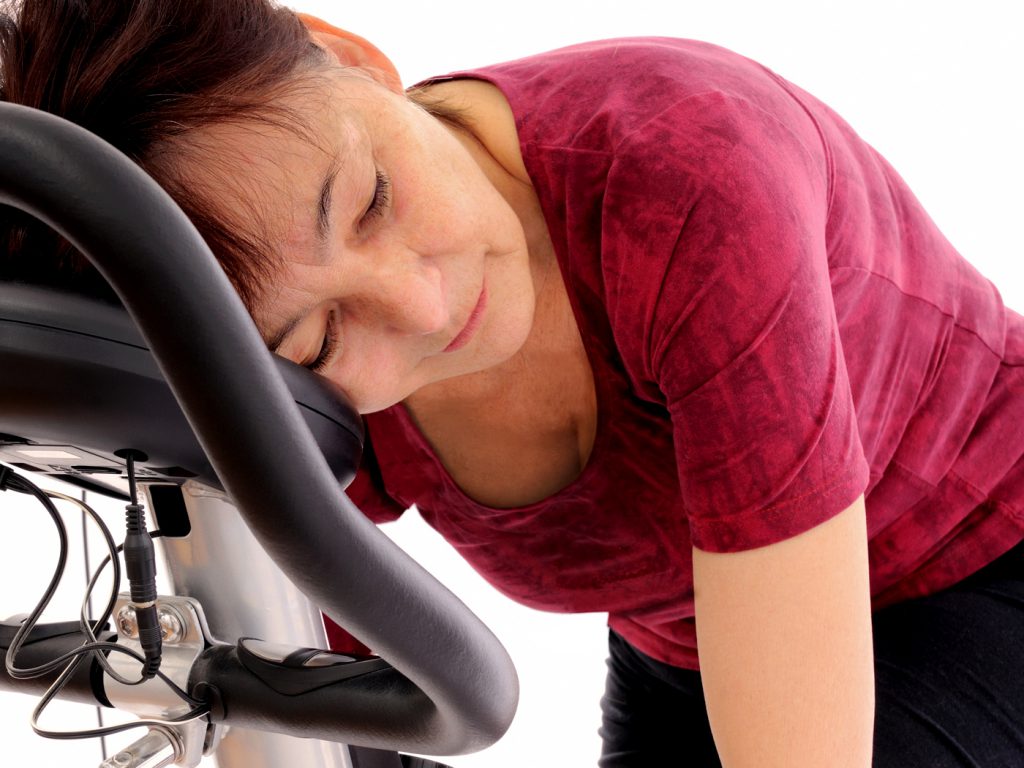5 Signs You Shouldn’t Try to Push Through a Workout
Here’s when taking a break is the best thing you can do for your body, plus tips on resuming exercise safely.

Exercise can be uncomfortable. After all, challenging your body to do something it’s not used to doing—whether it’s cranking out one more rep or pushing through an extra quarter-mile—is often the goal of an effective workout routine.
But how do you distinguish between healthy discomfort and danger? At what point are the potential perks of a good workout not worth risking your health and safety?
The simple answer: Learn to listen to your body’s warning signs. Here are five times it’s better to sideline yourself instead of sucking it up, plus tips on resuming exercise safely.
1. You’re Sick Below the Neck
If your symptoms strike below the neck (think: chest congestion, fever, or diarrhea), do not exercise, advises Michael Rebold, Ph.D., director of integrative exercise science at Hiram College in Ohio.
These symptoms signal that your body is trying to fight off a pretty significant infection. For it to do so effectively, your body needs to focus its energy there, says Polly de Mille, R.N., C.S.C.S., a clinical supervisor at the Hospital for Special Surgery in New York City. Instead of adding the extra stress of exercise to your system, stay home and rest.
When can you work out again? Once your symptoms have subsided, you’ve been fever-free for at least 48 hours, and you are well hydrated (vomiting, diarrhea, and fever can all result in dehydration), you can slowly ease back into your workout routine, Rebold says.
However, if your symptoms are exclusively above the neck—perhaps you have a stuffy nose or a headache—moving may help you feel better, he says. Low- and moderate-intensity exercise can reduce aches and pains by promoting circulation and increasing the body’s production of pain-fighting endorphins. Yoga, stretching, and light cardio like walking are all good choices.
If you choose to exercise when under the weather, follow the 10-minute rule: Every 10 minutes, check in with yourself to gauge how you’re feeling, Rebold says. If you’re feeling good, carry on. But if you feel worse than when you started, call it quits.
One last note: Your fellow gym-goers don’t want your germs, so it’s best to fit in some movement at home. Try this seven-minute yoga flow or this gentle stretching routine you can do in a chair.
2. You’re Running on Less Than 5 Hours of Sleep
Exercise can perk you up when you’re low on energy, but that’s not the same as being sleep-deprived. Pushing through when you’re battling significant fatigue can interfere with your body’s ability to recover from your workout while also increasing your chances of injury, Rebold says. Fatigue can decrease your fine motor skills, cause shortness of breath and dizziness, compromise your form, and throw off your balance, he explains.
Ultimately, deciding between a workout and a nap comes down to the individual. As a general rule of thumb, if you’ve had two or more nights of minimal sleep or you’re running on less than five hours, use the time you’d be at the gym to rest, recommends Josh Hillis, C.P.T., author of Fat Loss Happens on Monday.
If you’re feeling tired but not ready to forgo fitness altogether, opt for low-intensity, preferably seated, exercise, Rebold says. This will reduce the risk of overstressing your body or getting injured. One great option: the stationary bike. Check out our beginner’s guide to get the most out of this classic, joint-friendly cardio machine.
3. You’re Still Sore from Monday’s Workout on Thursday
Muscle soreness that occurs in the 24 to 48 hours after a tough workout, called delayed-onset muscle soreness (DOMS), is a sign of progress. That’s because exercise causes tiny tears in muscle tissue, and as your body repairs, it will bounce back stronger than it was before.
However, if that soreness lingers or gets worse after a few days, it could be a sign that you’re injured, says Michael Silverman, P.T., director of rehabilitation and wellness at Northern Westchester Hospital in Mount Kisco, New York.
Other signs of injury include:
- Tenderness to the touch
- Sharp or stinging sensations
- Limited range of motion
- Swelling or redness
- Pain that you would rank as greater than a 5 out of 10
Any attempts to push through these sensations during a workout will only exacerbate the problem and delay healing. It may also lead to injuries elsewhere in your body. Remember: Everything is connected, and when one tissue is injured, surrounding ones pick up the slack.
At minimum, wait until the soreness subsides before returning to your workouts. You may also benefit from making an appointment with your doctor or a physical therapist for safe exercise recommendations, Rebold says.
4. You’re Lightheaded or Dizzy
Whether you’re mid-jumping jack, mountain pose, or jazz hands, if you start to feel lightheaded or dizzy, stop what you’re doing and transition to a comfortable seated or lying position.
Subscribe to our newsletter
It's quick and easy. You could be one of the 13 million people who are eligible.
Already a member? Click to discover our 15,000+ participating locations.
Follow Us
Getting lightheaded could be a sign of a temporary problem like low blood sugar, dehydration, or pushing yourself too hard too fast, Hillis says. The solution might be as simple as eating a snack, drinking water, or dialing back the intensity of the workout. However, feeling dizzy or lightheaded could be also be an indication of a chronic cardiovascular (heart and circulatory), respiratory (breathing), or metabolic (blood sugar) problem, he says.
Unless the cause for your lightheadedness is incredibly obvious—maybe you got dizzy the second a super-challenging program came on your elliptical machine’s screen—talk to your doc to rule out more serious issues.
5. You Experience Chest Pain or Pressure
In terms of potential seriousness, this warning sign is the most severe. A cardiac event, such as a heart attack, is relatively rare during exercise. It’s most likely to occur in a person with underlying heart disease. However, people often aren’t aware they have a heart issue until they experience the warning signs of chest pain, pressure, or discomfort.
These are more likely to surface during physical exertion than at rest, so a workout might be the first time these symptoms manifest. Experiencing them during a workout is an indicator to stop immediately and notify someone working at your fitness center, Hillis says. Or if you’re at home, call 911.
While it’s completely possible that the cause is totally benign, it’s always best to play it safe when there’s potential for heart issues, he says.
What else you can do: Don’t wait until you have a scary experience at the gym to think about your heart. Talk to your doctor now about how you can prevent or manage heart disease. Already had a heart attack? Safe exercise can help you avoid a second one—and regain strength, energy, and confidence. Here are nine things you should do after a heart attack.
Take Your Favorite SilverSneakers Classes Online!
SilverSneakers members can access live fitness classes and wellness workshops through SilverSneakers LIVE. See the latest schedule and RSVP for classes here.
Not a member? If you have a Medicare Plan, it may include SilverSneakers—at no additional cost. Check your eligibility instantly here.





